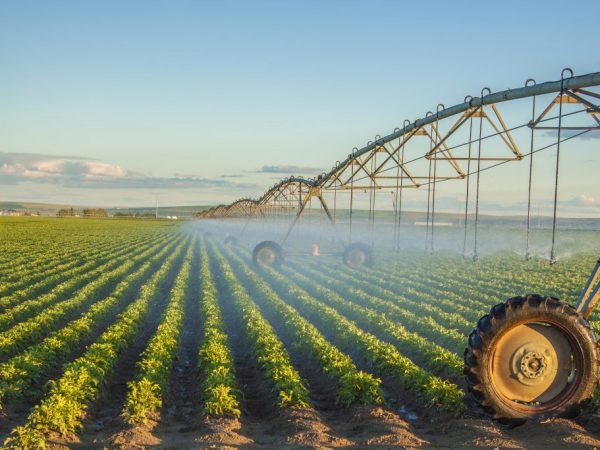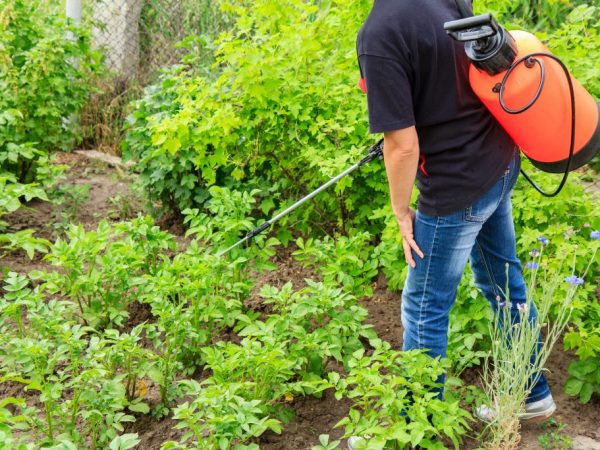Carrying out foliar feeding of potatoes
Foliar dressing of potatoes is often used to provide a vegetable crop with the required nutrients, which is the key to a good future harvest.

Carrying out foliar feeding of potatoes
Foliar feeding action
Leafy nutrition, which is often used in growing vegetables, can provide up to 100% of the yield. This is due to the fact that, by nature, potatoes have the strongest susceptibility to foliar nutrition due to the ability of its leaves to assimilate nutrients required for growth and development with rapid intensity. In the process of such feeding, not only the leafy part of the plant takes part, but also the stems with inflorescences, which gives a high degree of absorption and assimilation of the applied fertilizers.
Nutrients, macro- and microelements, which enter during foliar feeding, react with that part of the potato bush that requires it and needs feeding.
Unlike root feeding, which is usual for gardeners, which requires the introduction of a large amount of fertilizer due to the reduced susceptibility of potatoes to it, foliar can reduce material costs for fertilizing vegetable crops.
Features and timing
Leaf nutrition of a potato crop has its own specifics. Spraying with solutions with organic and inorganic fertilizers requires additional techniques and compliance with the deadlines provided for this.
Surfactants
If spraying is done incorrectly, the stratified epithelium of the plant's leaf blades, covered with a waxy protective film with cutin on top, becomes a persistent barrier to the penetration of the nutrient solution.
The natural barrier layer of the leaves reduces the effective effect of foliar nutrition at least threefold.
In order to overcome this obstacle to increase the rate of penetration of top dressing into plant cells, experienced gardeners resort to the use of specially designed agents - surfactants, or surface active substances, also called adjuvants.
In many cases, adjuvants are already included in the formulation intended for feeding vegetables. The instructions will tell you about their presence as a component. When surfactants are not included in the preparation, it is purchased separately and added to the spray solution.
The point of using adjuvants is to increase the area of liquid spreading on the leaf surface, destroy the protective layer of the leaf plate and retain nutrients through the formed microdamages in the leaf surface.
Timing
Among the terms when you need to carry out leaf bait, there are four main stages:
- the initial fertilization is carried out 15-20 days after the tubers are planted in the soil, when there is a need for nitrogen fertilizers, urea is the best foliar feeding during this period,
- secondary processing falls on the flowering period of a potato crop and requires a complex solution, which involves solutions of copper sulfate, potassium chloride, ammonium nitrate, superphosphate,
- the third and fourth baits are carried out with fertilizers, in which boron, iron, manganese, potassium and magnesium are present among the main components.
Each gardener has his own recipes for potato bait that help plant growth and act as a means of prevention in the fight against fungal diseases:
- protect vegetables from nematodes through nitrogen spraying,
- nettle infusions are more often used to effectively fight aphids,
- copper sulfate is known as a remedy against late blight and a way to increase the shelf life of a crop,
- boron is used so that there are no voids in the grown tubers,
- Manganese, which is part of the solutions, improves the taste and sugar content of potatoes.
Treatment of plants with boron with manganese and the use of potassium are carried out at the stage of formation of potato tubers, when flowering is over. The ready-made preparation Azofosk is often used. Spraying with urea has a beneficial effect on the growth of tops. In the last stages of potato crop development, three weeks before harvest, superphosphate treatment is carried out. During the entire growing season, humates are used.
Schemes and recipes for foliar feeding

The composition of the fertilizer depends on the stage of plant growth
The use of a particular composition for potatoes depends on the stage of development of the vegetable crop.
Humates
They are used throughout the growing season, starting from the fourth leaf on the sprout. There are ready-made solutions, for example Humate 7, which are diluted with 2 grams per ten-liter bucket. The consumption of such a bait will be about 3 liters per 1 hundred square meters of planting.
Urea
Foliar dressing of potatoes with urea is used during the period when the first shoots appear. Urea treatment contains nitrogen and thereby compensates for its deficiency at the initial stage of plant development. Urea spray solution includes:
- 10 l of water,
- 0.2 kg of urea,
- 0.3 kg of potassium monophosphate,
- 10 grams of boron acid.
Urea spraying is used often, before the flowering stage, subject to a two-week break between treatments. In secondary and subsequent spraying, an increase in concentration is allowed when the amount of water is reduced to 5 liters. In some cases, ready-made micronutrient fertilizers are added to the urea solution.
Copper sulfate
It protects the growing potato shoots from diseases and pests and provides adequate nutrition for the development of potato tubers. Spraying with copper sulfate is carried out at the flowering stage and includes a set of components:
- ammonium nitrate and potassium chloride - 2 g each,
- superphosphate - 20 gr,
- copper sulfate - 0.1 g,
- water - 10 liters.
Boron with manganese
At the end of the flowering process at the ripening phase of root crops, it is recommended to feed the potatoes with boron and manganese. For this there is a ready-made preparation Mag-bor, which is diluted in the proportion of a large spoon (15 g) per ten liter amount of water. Together with them, foliar feeding of potatoes with potassium can be carried out.
Phosphorus
Foliar feeding of potatoes with superphosphate occurs at the end of the growing stage of development of a vegetable crop. Superphosphate is the key to improving the taste of potatoes and increasing the keeping quality and shelf life of the future potato harvest. For spraying, 100 g of superphosphate is diluted in 10 liters of water.
Rules of conduct
Due to the specific structural feature of the leaf plate in potatoes with a dense film protection, feeding potatoes requires certain rules to ensure greater efficiency in the supply of nutrients to the plant cells.
- First of all, it will be useless to spray in the rain or directly in front of it, since the digestion of the resulting top dressing by potatoes takes at least 3 hours.
- When feeding, it is not recommended to exceed the permissible dosage.
- With the onset of frost, potato dressing is postponed until the onset of heat.
- In order to avoid getting burned by potato bushes, top dressing is not carried out in hot weather. For this, the morning or evening hours are selected.
- It is recommended to choose a small-droplet spray gun for spraying.
These simple rules for foliar feeding of potatoes will provide the plants with proper nutrition and bring the expected potato yield.


